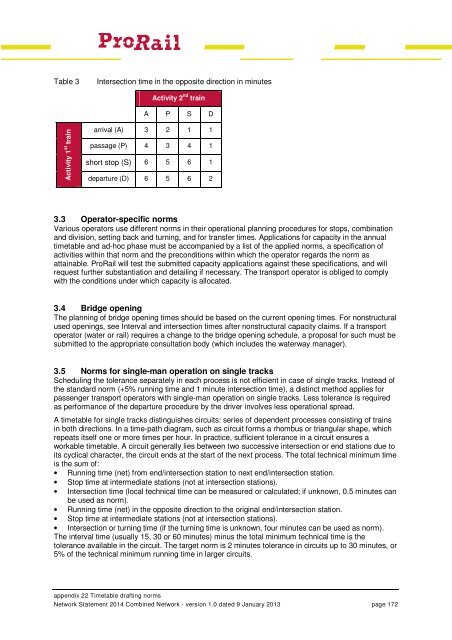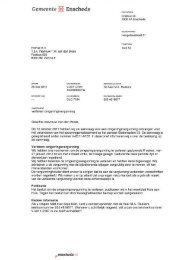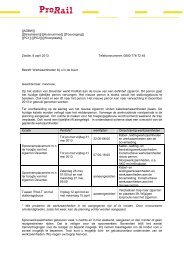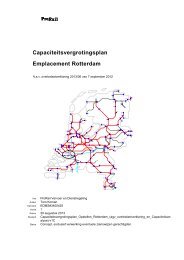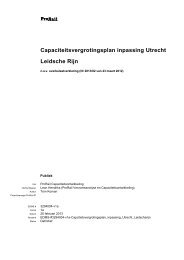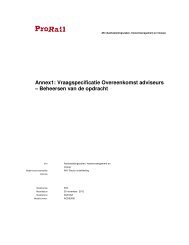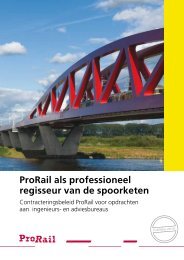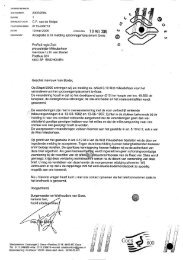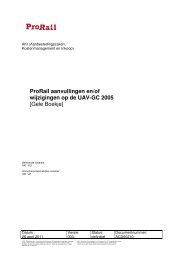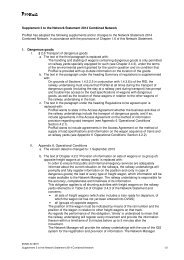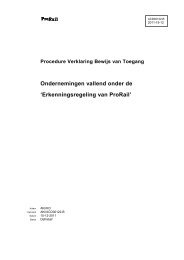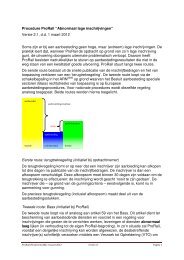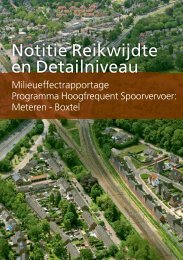Network Statement 2014 - ProRail
Network Statement 2014 - ProRail
Network Statement 2014 - ProRail
- No tags were found...
Create successful ePaper yourself
Turn your PDF publications into a flip-book with our unique Google optimized e-Paper software.
Table 3Intersection time in the opposite direction in minutesActivity 2 nd trainA P S DActivity 1 st trainarrival (A) 3 2 1 1passage (P) 4 3 4 1short stop (S) 6 5 6 1departure (D) 6 5 6 23.3 Operator-specific normsVarious operators use different norms in their operational planning procedures for stops, combinationand division, setting back and turning, and for transfer times. Applications for capacity in the annualtimetable and ad-hoc phase must be accompanied by a list of the applied norms, a specification ofactivities within that norm and the preconditions within which the operator regards the norm asattainable. <strong>ProRail</strong> will test the submitted capacity applications against these specifications, and willrequest further substantiation and detailing if necessary. The transport operator is obliged to complywith the conditions under which capacity is allocated.3.4 Bridge openingThe planning of bridge opening times should be based on the current opening times. For nonstructuralused openings, see Interval and intersection times after nonstructural capacity claims. If a transportoperator (water or rail) requires a change to the bridge opening schedule, a proposal for such must besubmitted to the appropriate consultation body (which includes the waterway manager).3.5 Norms for single-man operation on single tracksScheduling the tolerance separately in each process is not efficient in case of single tracks. Instead ofthe standard norm (+5% running time and 1 minute intersection time), a distinct method applies forpassenger transport operators with single-man operation on single tracks. Less tolerance is requiredas performance of the departure procedure by the driver involves less operational spread.A timetable for single tracks distinguishes circuits: series of dependent processes consisting of trainsin both directions. In a time-path diagram, such as circuit forms a rhombus or triangular shape, whichrepeats itself one or more times per hour. In practice, sufficient tolerance in a circuit ensures aworkable timetable. A circuit generally lies between two successive intersection or end stations due toits cyclical character, the circuit ends at the start of the next process. The total technical minimum timeis the sum of:• Running time (net) from end/intersection station to next end/intersection station.• Stop time at intermediate stations (not at intersection stations).• Intersection time (local technical time can be measured or calculated; if unknown, 0.5 minutes canbe used as norm).• Running time (net) in the opposite direction to the original end/intersection station.• Stop time at intermediate stations (not at intersection stations).• Intersection or turning time (if the turning time is unknown, four minutes can be used as norm).The interval time (usually 15, 30 or 60 minutes) minus the total minimum technical time is thetolerance available in the circuit. The target norm is 2 minutes tolerance in circuits up to 30 minutes, or5% of the technical minimum running time in larger circuits.appendix 22 Timetable drafting norms<strong>Network</strong> <strong>Statement</strong> <strong>2014</strong> Combined <strong>Network</strong> - version 1.0 dated 9 January 2013 page 172


